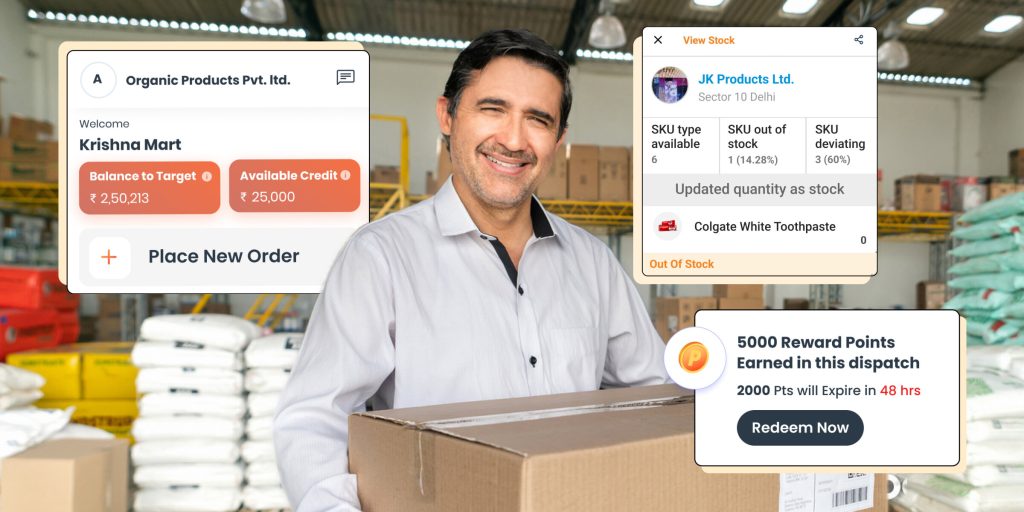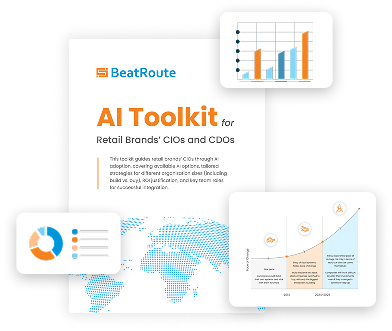What is a Distribution Management System? BeatRoute’s 2025 Guide

A Distribution Management System (DMS) is a software used by retail brands’ distributors to streamline order processing, inventory management, and sales tracking. It enables real-time stock visibility, order processing, incentive tracking and digital trade between brands and distributors. By improving secondary sales processes and distributor engagement, a distribution management system helps brands optimize their route-to-market execution and enhance overall supply chain efficiency.
A DMS is the backbone of a brand’s route-to-market strategy, enabling efficient distribution across general trade, modern trade, and B2B or HoReCa channels. It helps brands make data-driven decisions, prevent stockouts, optimize inventory, and enhance digital engagement with distributors.
Distributors play a crucial role in ensuring products reach retailers efficiently, but challenges like lack of secondary sales transparency, stock mismanagement, communication gaps, and weak engagement can disrupt the collaboration between brands and distributors. Without real-time insights, brands struggle to track demand, prevent overstocking, and respond to market changes. Distributors also face inefficiencies in ordering, incentive tracking, and sales performance, leading to delays and loyalty issues.
While many existing Distributor Management Systems attempt to address secondary sales tracking, most fail to manage primary sales effectively. This results in distributors missing timely stock alerts, struggling with manual order placements, and lacking the ability to self-order, which can cause delays and lost sales opportunities. Similarly, a lack of real-time access to sales targets and incentives can weaken engagement and motivation among distributors. The need for a holistic, intelligent, and easy-to-use distribution management system has never been more critical.
When designed and implemented effectively, a DMS acts as the central nervous system of a brand’s distribution network, helping businesses proactively manage inventory, prevent stock imbalances, and improve overall supply chain efficiency. It brings together key functions such as order management, inventory tracking, invoicing, promotions, and analytics, enabling brands to monitor and optimize their sales operations with precision. Most importantly, by leveraging real-time data from distributors, brands can make smarter, faster decisions that drive growth and improve customer fulfillment.
Who uses a Distribution Management System
A well-implemented Distribution Management System is critical for brands in industries that rely on multi-tiered distribution networks, including:
- FMCG (Fast-Moving Consumer Goods) – Managing high-volume transactions and secondary sales with multiple distributors.
- Consumer Goods – Optimizing distribution across diverse retail formats.
- Building Materials – Tracking dealer and distributor sales efficiently.
- Pharmaceuticals – Ensuring regulatory compliance and improving inventory visibility.
- Automotive and Auto Ancillary – Managing spare parts distribution and stock replenishment.
In these industries, the distribution management system is used by the retail distributors and stockists of the brands.
Challenges in Distribution Management Systems
| Problem | Why It’s a Challenge | Solution |
| Manual order placement | Distributors rely on phone calls or spreadsheets for placing primary orders, causing errors and delays. | Enable distributors to place primary orders to the brand digitally with AI order recommendations. |
| Ineffective scheme utilization | Distributors do not see incentive schemes during ordering. | Display incentives and primary trade schemes during ordering for better engagement. |
| Distributors do not see their targets and current progress | Distributors lack visibility on their sales targets, reducing motivation. | Show distributors their real-time progress against targets, boosting engagement. |
| Stock mismanagement | No real-time stock tracking leads to overstocking or stockouts. | Enable inventory management and stock-deviation alerts. |
| Distributors resist DMS adoption | Traditional DMS tools feel brand-centric and lack distributor benefits. | Ensure a user-friendly interface with distributor-first features. |
| Distributors do not have access to analytics tools and insights | Distributors make decisions based on intuition rather than data-driven insights. | Provide distributors with brand-configured analytics and insights to optimize sales performance. |
Challenges faced by distributors mainly arise from various disruptive factors that can be human, logistical, or product-related.
From changing market demand to recalls or quality control problems to product returns or order cancellation, the challenges are many that more than necessitate the need for excellent distribution channel management.
Let’s dive into the different challenges that a distributor and/or a brand can encounter while pushing products down the sales hierarchy.
Challenges encountered by brands
- Secondary Sales Visibility
Secondary sales is an important aspect of trading where intermediaries are involved to get the product to the consumer. Secondary sales happen between distributor and retailer/dealer, and the data here is commonly opaque to brands. The ramifications can be expensive as brands may miss out on important areas of improvement or issues down the supply chain.
For example, it is a grave mistake for brands to assume that once a batch of products have gone out to the retailer or dealer, there are no further worries. Retailers/dealers can return products based on issues like products nearing expiry or broken seals. If brands are accurately informed of this on a timely basis, they can improve their quality check procedures or if need be, rethink their entire strategy.
- Inadequate Incentive for Primary Sales
Distributors need persuasion to increase their business volume with you; they need rewards and lucrative schemes to continue pushing your products in the market. Your distributor schemes must stand out from competitors’ offers to be attractive. Higher purchases from distributors mean more primary sales, which strengthens your route to market. The challenge, however, is not only to design these schemes but also to make them visible to distributors during ordering. Without this, you risk a major decline in primary sales.
- Inadequate Fill Rate
The amount of products a brand can supply through distributors to retailers depends on consumer demand and stock availability. As such, without the right data, both historical and current, maintaining a steady supply-demand ratio is extremely problematic. For example, if a brand sends out a hundred items to a distributor and half of those go unsold, the brand would need to re-strategize in the next month or quarter. This is only possible when there is actionable data available to go from.
- Varying Trade Scheme Efficacy
Trade schemes are designed or formulated by a brand to make their products or a certain section of their products more lucrative for a retailer. Sometimes free products are handed out when retailers buy a certain amount of a certain product and sometimes great discounts are available for retailers.
Like all strategies, trade schemes may or may not work every time and visibility on the same would help with strategizing and allow for proactive actions like better schemes or a redo. By getting visibility into the distributors’ billing operations, brands can also ensure that the retailers are billed with the right schemes being applied on their orders.
Challenges encountered by distributors
A common shortcoming of traditional DMS tools is that they focus on helping the brand in terms of visibility, tracking, and other functions. They barely do much for the distributors, who are responsible for being the channel that gets the brand’s products to retailers’ shelves. There is no visibility for the distributors when it comes to checking the orders placed with the brand or even tracking the same. Communication also takes a hit.
This is one of the primary reasons for distributors not putting much stock in distribution management systems; the result could be a strained brand-distributor relationship.
- Lack of Account Statement for Distributors
There are times when distributors hesitate to clear their dues due to uncertainty over previous payments. They may worry that past payments might not have been correctly recorded or gone through, potentially impacting their credit or leading to future financial loss. This lack of clarity results in lost time that could be better spent on other more important priorities, like addressing product issues. Additionally, non-configurable invoicing systems that can’t adapt to local regulatory requirements or include necessary statutory details pose further challenges.
- Absence of a Robust Claims Process
Distributors may encounter issues such as damaged goods, expired products, or customer-focused trade promotions where they sell to retailers (secondary sales) at a lower price than their initial purchase cost (primary sales). These situations necessitate returns, chargebacks, or claims, which must be filed for each. Without a streamlined process, filing these claims can become tedious or significantly delayed, leading to distributor dissatisfaction, potential brand damage, and lost sales opportunities for a brand.
- Lack of Distributor Enablement
Distributors are responsible for conducting secondary sales and it is a significant roadblock to that when they see diminishing stock at their warehouse but can’t act on it and self order. Worse of all, in the absence of timely nudges or analytics, they don’t realise about diminishing stock until it’s too late, leading to lost sales at retailers’. Both of these require a dependable digital solution at the primary sales level.
- Lack of Deployment Foresight
You can’t always deploy something that there is no need for. As a brand, you may have purchased a well-envisioned distribution management system with all the functionalities and capabilities you need. But many of your distributors might already be using a DMS they trust, using an accounting system such as Tally as their distribution software, or your distribution management system may not be able to integrate with their systems.
- Absence of Scalability
Technology and businesses are always in flux. Trends change, new concepts are introduced, and business goals vary with time. Uncertainty like that requires you to have a distribution management system that is easily scalable for the future as opposed to rigid architectures where you have to accommodate new features or business verticals by re-developing the application from the ground up.
- Lack of DMS Adoption
The biggest roadblock to adopting a new software is the value it offers to the user/purchaser. Distributors believe that a distribution management system is brand-focused and all benefits with it are for the brand. As brands push for visibility on secondary sales, some distributors want to keep to the current status quo because the opacity benefits them in specific ways.
For example, consider a trade discount or scheme by the brand that offers the distributor a discount/order for delivering a 1000 items in one order. The distributor may not be able to fulfil the criterion but could underhandedly combine multiple orders into one invoice or bill to reach the requisite number. The distributor could then present this fabricated document to the brand and receive the discount or reward.
- Failure to Make DMS Accessible
User friendliness or the lack thereof can make or break an innovation. Same goes for a DMS; it must be designed in a way to enable even beginners to use it seamlessly. A distribution management system with a cumbersome UI, shabby design, complicated navigation or simply long load/buffer times are all hindrances to a great user experience and would never be the mainstay for successful distribution management. Similarly, many rural distributors may not be able to use a full-fledged desktop DMS as they might be operating from their mobile devices most of the time.
- Lack of Maintenance
A DMS, like any other software is dependent on timely updates and general maintenance efforts to stay in top shape. What this means is that regular patches or bug fixes or simply a feature upgrade must be facilitated whenever possible or on a fixed but frequent schedule to account for growing business needs and cybersecurity. When a distribution management system fails to do that appropriately, it fails to become a premier or even a relevant solution.
How a Distribution Management System Solves Key Challenges

- Manages Resource and Inventory
Great distribution management systems support resource management with effective deliveries, returns, and payment collection, utilising comprehensive and reliable reports to help with sales goals. The best processes are a mix of man and machine, in that a truly efficient distribution management system will nudge distributors proactively towards ordering from the brand when their stocks are nearing outage. This saves time, effort, and mitigates strictly human errors.
When correctly integrated within a supply chain, a modern distribution management system should eliminate most fill rate and stock issues.
- Streamlines Order Management
It doesn’t take a genius to figure out that effective distribution management leads to effective order management through processes and communication focused on brand goals. This aspect affects the entire supply chain, directly or otherwise, by reducing concerns on delays, unnecessary orders, and lost opportunities.
For example, if a certain order is out for delivery and there is a delay, a distribution management system should be able to make that evident for all trade partners involved so that a solution can be reached with maximum speed and efficiency.
- Enables Distributors
Limiting distributor digitisation restricts their ability to place orders, leaving their stock levels dependent on your sales team. This means distributors may have to wait for sales visits or rely on phone calls to order, leading to delays and impacting your route-to-market efficiency. Rather, implementing a Distributor Management System (DMS) that proactively prompts distributors to order when stock is low can resolve any understocking issues. With convenient access to a distribution management system via platforms like WhatsApp or Viber, distributors can easily view products and schemes, and place orders independently, leveraging social media to improve accessibility.
- Communicates Payment Information to Distributors
Payment issues can significantly strain the relationship between a brand and its distributors. Thus, both parties need full transparency regarding transactions, available credit, and more through a clear statement of account. The BeatRoute DMS provides complete visibility into credit and debit notes and statements of account, ensuring clarity and resolving payment queries before they lead to misunderstandings or dissatisfaction.
- Incentivises Distributors and Drives Successful Primary Sales
As a brand, you must offer attractive schemes that encourage distributors to stock a wider range and quantity of your products and drive repeat business for you. By providing easy access to their distribution management system through WhatsApp or Viber, distributors gain full visibility into schemes and sales targets, ensuring your primary sales consistently meet expectations and retail orders are reliably fulfilled.
- Drives Strategic Secondary Promotions and Cost
Promotional offers and pricing directly drive sales, both customer and consumer facing. Businesses with foresight will implement them for sure, but with a DMS that can accurately record these and remind/nudge when necessary can lead to more profits and even successful product launches.
A distribution management system would equip brands with performance data of the product lines/categories and distributors, and also generate custom promotions based on achievable milestones. This motivates distributors to produce better results.
- Ensures Well-organised Payment Collection
All the best systems and distribution management in the world is incomplete without an effective payment collection feature. To see the fruits of your labour, or in this case, of your distribution management system, you need to look at revenue and profits. An advanced distribution management system ensures that payments, payment reminders, invoicing, etc. are well-organised and robust to make things easier for the brand.
- Sets Up an Effective Claim Management Process
Claims from distributors such as returns, defective items, reward redemption and more comes with the territory for brands. Naturally, when a brand is able to fulfil them on one single platform and do so with ease, they are able to do a better job at appeasing their channel partners and setting up a long-term relationship with them.
- Ensures Effective Reporting
Reporting is the final piece to the puzzle when you have set up your distribution management system because without reporting, you don’t have any visibility on what’s going on. A user-friendly interface is crucial in this respect where all relevant data or KPIs are clearly visible and reports are available for download. Ideally, these reports should be neatly segregated in terms of regularity (daily, weekly, monthly, and annually) to help with prediction and goals.
The Future of Distribution Management Systems: Key Trends
Trends are ever changing patterns that are dependent on consumer behaviour and affect it at the same time. Ever changing, these are different from fads which are short lived or don’t have a lasting effect. Distribution management is no different and it is smart to keep an eye on current and future trends to anticipate development.
We discuss some of these in the following points:
Empowering Distributors as Growth Partners
A Distribution Management System should not just track distributor performance but actively empower them as strategic partners rather than passive intermediaries. Key ideas:
- Self-ordering capabilities to reduce dependency on sales teams
- Real-time access to sales targets for better goal alignment
- Incentive visibility to keep distributors motivated
- AI-driven insights for smarter decision-making
By providing these benefits to distributors, brands can enable them to make proactive decisions that drive higher sales. A collaborative approach strengthens distributor relationships, improves order fulfillment efficiency, and ensures greater alignment with business goals. Ultimately, this creates a win-win ecosystem where distributors are motivated to push the brand’s products more effectively.
Data-Driven Distribution Management
Effective distribution management relies on acquiring and utilizing accurate data to enhance existing processes and build a strong foundation for future growth. A distribution management system provides real-time insights into:
- Channel throughput to monitor sales performance
- Stock levels to prevent overstocking or stockouts
- Distribution bottlenecks to improve efficiency
With the rise of advanced analytics tools, companies can access critical data in multiple formats at the click of a button, allowing for proactive decision-making. Organizations that prioritize data-driven strategies are better equipped to detect and resolve inefficiencies before they escalate into major challenges, ensuring smoother operations and optimized resource allocation.
Scalability and Modularity in a DMS
A modern Distribution Management System should be both scalable and modular, allowing brands to customize it based on their unique requirements without relying on programmers.
Scalability
Every business has unique needs, making customization essential rather than optional. A scalable distribution management system allows brands to:
- Adapt to changing technologies and market demands
- Configure KPIs and features without technical expertise
- Give distributors and brands more control over their operations
A future-proof distribution management system should be easily scalable without requiring extensive redevelopment, ensuring brands remain competitive and adaptable.
Modularity
A modular DMS allows brands to:
- Choose only the features they need for their workflow
- Avoid unnecessary complexity by removing redundant features
- Improve user flexibility for a more customized experience
With a modular design, brands can tailor their DMS to their specific distribution model, creating an efficient, streamlined, and precise system.
SaaS instead of Traditional DMS
Companies are increasingly adopting Software-as-a-Service (SaaS) solutions for distribution management because of:
- Scalability: SaaS-based DMS solutions grow with the business
- Continuous updates: Frequent updates keep the platform relevant
- Business continuity: No risk of system obsolescence
- Lower maintenance overhead: SaaS eliminates the need for complex IT management
By adopting a scalable, modular, and SaaS-based DMS, brands can ensure long-term efficiency, better distributor collaboration, and continuous innovation in their distribution management strategy.
Essential Features of a Modern Distribution Management System

Distribution management is conceptually dependent on the distribution of goods from point of origin to the retailer or dealer in a timely and effective manner. Order fulfilment as opposed to just transportation. To accomplish this, sales and distribution professionals must understand the market and the product they are responsible for.
As a business leader, you may know that effective distribution management is an integral part of getting your products sold but here is why:
- It makes sure that there is sufficient stock available whenever customers or consumers are in need of your product. There is no delay and supply always meets demand.
- You reach more and more consumers with the right system in place and access to numerous channel partners.
- You save a ton of money with slashed inventory costs and the most cost-effective distribution.
- You also ensure happy retailers through on-time delivery of intact products.
A distribution management system that works for you will offer the following strategic upgrades:
- Provide practical goal measurement
A clear view of the supply chain and end-to-end processes assures the creation of sales strategies that produce great results. Seeing the information end-to-end facilitates planning of cohesive sales strategies. When you are able to predict growth opportunities by using a distribution management system, you all but ensure success for your brand.
- Manage your channels adequately
When you are able to see the individual stats of distributors and how they are doing in terms of order fulfilment, inventory and more, you will be more clear on how to sustain and push forward your relationship with them.
- Efficiently manage time and effort
Automation is just a spoke in the wheel called progress and for a distribution management system, this means that it will save a lot of time and energy with communication and order fulfilment, so that you can take care of other crucial tasks.
BeatRoute’s Distribution Management System
As a goal-driven sales enablement platform with outstanding scalability and a modular design, BeatRoute is made for collaboration in both primary and secondary sales efforts. BeatRoute distribution management system is zero-code software, which means it allows for quick deployments and enables drag-and-drop configurability without involving any programming efforts. You can potentially scale it up or down as much as you need. You can also choose what features you want to add to your BeatRoute’s DMS as our platform is also modular; you don’t need to have what you don’t need.
BeatRoute’s DMS enables distributors to place digital orders, track order delivery, and view account statements – all to make life easier for them and promote ease of use.
With multiple interface options, our DMS is designed to allow all distributors, irrespective of their preference for a desktop or a mobile device, to readily adopt it. The Tally plugin is a gem of a feature that is targeted at those distributors who are already using Tally as their distribution or accounting software and are unlikely to switch to another DMS.
If a brand uses our field sales app, then there is a smooth and efficient flow of data between it and the DMS. However, even in case the brand is using another field sales app, BeatRoute’s DMS can seamlessly integrate with it and result in the same easy data flow as in the previous case.
All in all, with BeatRoute, you get a complete B2B eCommerce solution that digitalises the business between the brand and the distributors. This includes:
- Primary as well as Secondary sales management
- A flexible scheme engine
- Auto-application of relevant schemes
- Rapid and unambiguous claim approval
- Returns management
- Complete inventory visibility
- Primary sales insights for sales managers for meaningful engagement
- …and more!
Wondering how to choose the distribution management system that’s right for you? Read this.
Also get a free demo of how our DMS works!
About the Author
-
Apart from being a Senior Content Writer at BeatRoute, Soham is an avid reader of science fiction and suspense novels (Doyle, Christie, Brown or anybody great!) He also dabbles in historical narratives and wonders about our place in the universe. Cosmic viewpoints, Carl Sagan, and Neil deGrasse Tyson intrigues him. When not reading, you may find him spending his weekends or after-work hours watching a fulfilling movie with his family.
Use Goal-Driven AI to Achieve Retail Sales Uplift, Today!
Join enterprises in 20+ countries that trust BeatRoute, the globally dominant AI platform for sales force automation, field sales, DMS, and eB2B
Latest Insights & Articles
Here are the most impactful articles, platform updates, ebooks and reports for you.



